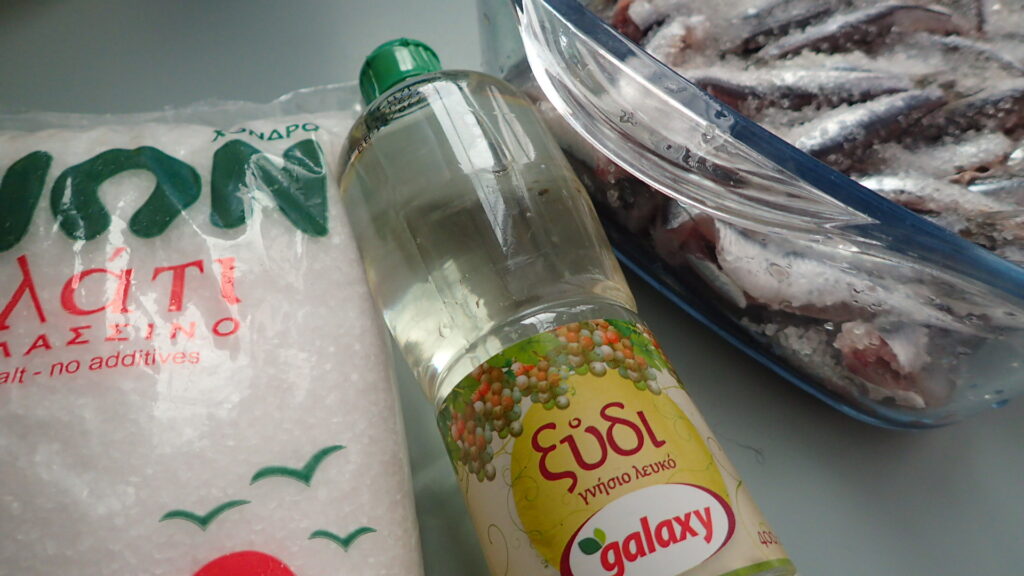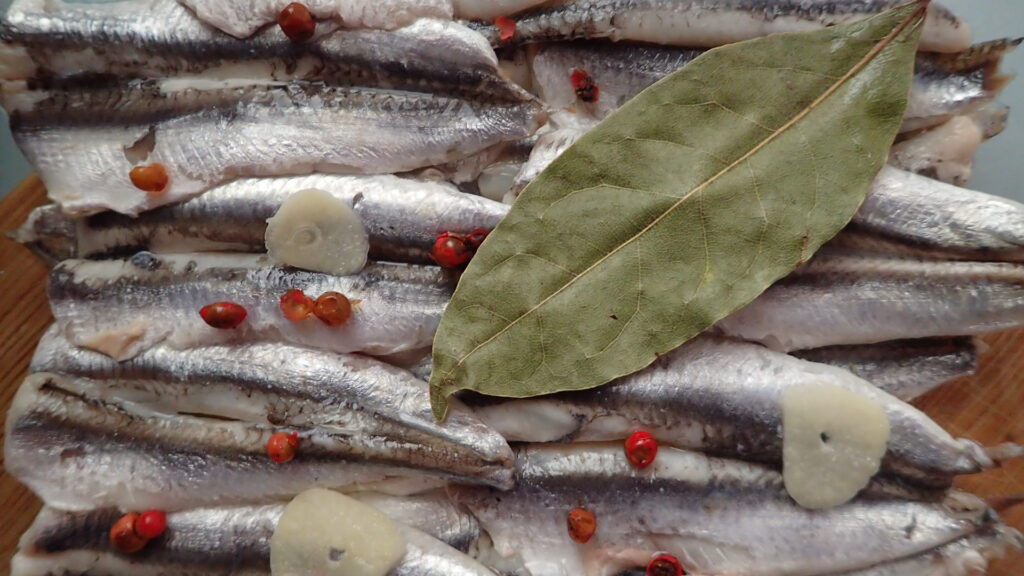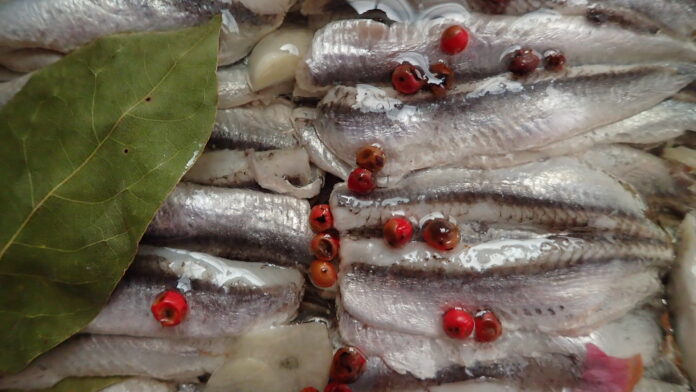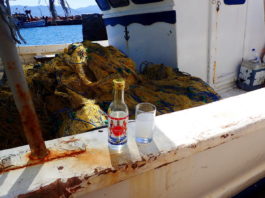Boquerones – called gavros marinatos (marinated anchovies) in Greek – are fresh anchovies in vinegar. These simple pickled anchovies are one of the easiest cured fish to make at home Gavros marinatos are the most elemental, essential meze – an elegant appetizer or tapas to enjoy with an apperitivo. They’re ideal with tsipouro or ouzo, and they’re zesty, piquant, and carb-free.
Table of Contents
What are Gavros Mariantos – Marinated Anchovies
These marinated fresh anchovies are cured and preserved with salt, while an acid – in the case, vinegar – “cooks” the fish, turning the anchovy fillets from translucent and gray to opaque and white, very much like ceviche.
How to Buy Fresh Anchovies for Boquerones – Marinated Anchovies

Fresh anchovies are a very common fish in Greek waters. Usually, they’re served cleaned, salted, and fried in just a dusting of flour. Humble, inexpensive, and nutritious, they’re a favorite protein on the Greek table. They’re plentiful throughout much of the year.
Like with all fish, you’ll want to look for bright eyes, and firm flesh. A good fresh anchovy should be so firm and springy that the skin looks taut and shiny. If you pick one up by the tail, it should not flop. They should smell clean and fresh like the sea. While they’re cured, so therefore not raw, we’ll use only the very freshest and best anchovies for making gavros marinatos.
How to Clean Fresh Anchovies for Gavros Mariantos

One of the easiest of all fish to clean is the anchovy. True, they’re small and a kilo (about two pounds) seems like a lot of them -perhaps 50-70 anchovies. But they have almost no scales, and often none at all, which mean much less mess and a much faster job. You’ll quickly get onto a rhythm.
First, check them all for scales by running the lade of a short sharp knife from tail to head. You may remove just a scale or two, and very often you’ll remove none at all. Rinse them well in a colander and give them a brisk shake to remove the excess water. Now grip one firmly by the middle and with your dominant hand, sever the head with a paring knife or any short sharp knife you feel comfortable with.
Don’t cut completely through, as you’ll be able to pull of the entrails which are attached to the head in one motion. If you can’t get the knack of it right away, don’t worry at all. You can remove the head, the make a incision in the belly and pull them out. With the very freshest of fish, this will all be surprisingly clean work – bloody, but not at all mushy. Discard the heads and entrails as you place the cleaned fish in a bowl. Once they’re all clean, give them a thorough rinse with several changes of water, and shake them dry.
We’ll soon butterfly them by removing the spine. But that’s much easier after step one.
Marinating the Anchovies for Greek Boquerones – Step One
Place the cleaned anchovies neatly in a small dish. It’s fine – better even – to pack them snugly together and in several layers. We’ll be covering them with vinegar, and the less space in between them, the less vinegar goes to waste.
Leave them for half an hour, and not much more. The vinegar will initially firm the flesh, but later break it down and cause it to be mushy. The vinegar will also make the bones a little more rubbery, and altogether much easier to remove.
How to Butterfly an Anchovy – Step Two

Remove the anchovies from the vinegar, flit from the belly down to the tail. Then run your thumb and forefinger down the spine to the tail, removing the spine. Flatten the anchovy fillet – the butterfly. Lots of them will split into to oblong halves. Don’t worry about it at all. They’ll look great and be delicious.
Packing the Anchovy Fillets in Salt – Step Three

Make a single flat layer of anchovies in a glass dish, and cover evenly with coarse salt. Then another layer, more salt, and so on, ending with a good coating of salt. Cover the dish and refrigerate for a couple of hours – at least two, and no more than five or six.
Drain them very well. You’ll be astonished at how much liquid the salt draws from them, firming them and further whitening them in the process.
After pouring off the moisture, cover them once again in vinegar for a a little more tang. Keeping testing them. You can make them as tangy as you like. But if you leave them too long, the vinegar will break the fillets down and make them mushy. White vinegar is the best choice, so as not to tint the fillets.
Rinsing the Anchovies
If you want your boquerones them very salty, you could just wipe them dry. But to make them not overpoweringly salty, it’s good to give the fillets a very quick rinse – not leaving them in water at all – and then pat the fillets dry with clean kitchen towels. Remove as much moisture as you can.
Taste one – gavros marinatos should be pleasingly salty, with a nice tang. If it’s too salty, rinse again. If it could use a little more salt, keep that in mind for the next step.
Classic Gavros Marinatos, With or Without Aromatics – Step 4

These are delicious with the briny taste of fish and the tang of vinegar – they don’t need much else. But they take very well to fresh garlic, bay leaves, black pepper, rosemary, or whatever else suits your tastes. Just go lightly so as not to overwhelm them.
Take the cured, dried fillets and place them neatly in a layer, adding a couple of slivers of garlic, a grinding of pepper, or whatever you wish, also correcting for salt if they need it. Keep layering neatly,. If you’re using bay leaves, just one or two for the entire dish should do it. Likewise, one or two garlic cloves should be enough, as garlic grows stronger over time.
When they are all neatly layered in the dish, cover them completely with vegetable oil – sunflower oil, canola, or anything with a neutral flavor. We love extra virgin olive oil, but it overwhelms them. You can drizzle some on when you serve them.
Storing the Gavros Marinatos
Keep your marinated anchovies in the refrigerator, covered completely with oil. As you remove a portion, you may need to top them up with more oil to make sure they’re all covered.
Serving Greek Gavros Marinatos
Greek style boquerones are a delicious ouzo meze. Salty things – a few olives, the gavros marinatos – are perfect. The also go well with wine and beer. They’re sleek and suave enough to make a great tapas with a glass of cava or prosecco – a perfect holiday treat when you want a break from rich and fatty things. They also make a fine tapas on a slice of buttered bread.
In Greece, bean soups and lentil soup are usually served with piquant sides – pickled vegetables, olives, and some smoked or marinated fish. These Greek boquerones round out a humble table.
Gavros Marinatos - Boquerones (Marinated Fresh Anchovies in Vinegar)
These tangy, salty, Greek marinated anchovies are sleek, sophisticated, delicious, keto-friendly, and low-fat.
Ingredients
- 1 Kilo fresh anchovies
- About 200 grams - 7 oz coarse salt
- 1-2 cups white vinegar or white wine vinegar
- 2 Bay Leaves (optional)
- Ground black pepper, or whole pink peppercorns (optional)
- 2 garlic cloves, sliced paper thin (optional)
- Fresh herbs to taste, such as rosemary or marjoram (optional)
Instructions
- Rinse and scale the anchovies.
- Remove the heads, pulling out the entrails as you do.
- Rinse the anchovies, shake dry, and cover with vinegar. Leave 30 minutes to make them easier to butterfly.
- Remove the anchovies from the vinegar and butterfly them.
- Place the fillets in layers in a glass dish, with a generous layer of coarse salt in between.
- Drain the liquid from the anchovies from time to time. After a couple of hours - up to 5 or 5 - they should have shed most of the liquid.
- Cover with vinegar again for about a half an hour. Leave them long enough to take on the flavor you like, but not so long as to break down and soften. They should be firm, opaque, and pearly.
- Rinse well but quickly and pat dry with clean kitchen towels. Taste one for salt and vinegar.
- Layer the fillets in a glass dish, adding aromatics of your choice sparingly throughout and correcting for salt if necessary.
- Cover completely with a neutral-tasting vegetable oil and store in the refrigerator.
Notes
Covered completely with oil and kept chilled, these can keep for weeks.




